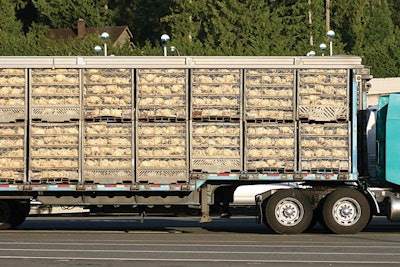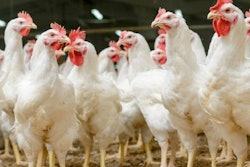
Conventional thinking surrounding animal welfare suggests creating an environment more similar to the nature leads to happier birds and better performance. But are the environmental enrichments and changes currently used in the broiler industry really helping?
A panel of animal welfare experts tackled this question, among others, as part of WATT Global Media’s panel discussion on measuring and improving broiler welfare. Appearing on the panel were: Jim Shepard, senior director live operations for Wayne Farms LLC; Dr. Stephanie Torrey, senior research scientist for animal biosciences at the University of Guelph; Dr. Joy Mench, professor emeritus for animal science department at the University of California at Davis; and Dr. Suzanne Dougherty, executive vice president of the American Association of Avian Pathologists and a consulting veterinarian with Pecking Around Consulting. The panel took place on February 1, 2018, as part of the 2018 International Production & Processing Expo in Atlanta.
Do engagements work?
A major aspect of broiler welfare programs is the addition of engagements that are designed to help the birds be more active and mentally engaged. This supposedly leads to better overall welfare.
Shepard said he was optimistic about the use of engagements at Wayne Farms. Ninety percent of what the company does in the name of animal welfare – including the engagements – comes back in the form of profits. The other 10 percent, he said, is done because it’s the right thing for the bird.
In 2017, Wayne Farms started raising some birds under the welfare standards established by the Global Animal Partnership (GAP) welfare rating system. In September 2017, it launched a line of products – Naked Truth – rated GAP Step 2, meaning the birds live in an enriched environment. GAP’s highest rank, of six in total, is Step 5+, where the birds spend their entire lives on the farm and are raised in an animal-centered and pastured environment.
As of February 2018, Wayne Farms converted less than 5 percent of its farms to meet GAP standards. But it will continue to increase the number of GAP farms to meet growing customer demand, according to Alan Sterling, director of marketing for Wayne Farms.
For specific engagements, Wayne Farms tested placing hay bales in the houses and attaching ropes above the feed lines. Both are designed to encourage the birds to move, perch and peck to occupy themselves.
Shepard said working with GAP is teaching him to have an open mind about engagements. While the hay bales are messy, the birds like to perch on the bales and they enjoy them. The next step will be adding perching structures to the broiler houses. Due to issues with the hay bales and the ropes, Wayne will likely move to enrichment huts as it continues to learn and experiment with the enriched environment.
Wayne Farms’ engagement huts are triangular, plastic structures designed to withstand pecking and scratching as well as provide shelter for the chickens. Sterling said the company is working closely with GAP and sharing the results of its testing, and seeking the group’s feedback, as it develops new enrichments.
The natural behavior issue
Many welfare programs aim to create an environment more similar to nature. This will supposedly lead to better welfare and performance. The problem with this concept, the panelists said, is the animal Gallus gallus domesticus is thoroughly removed from its native environment and influenced by thousands of years of domestication and breeding specializing in either growth for meat or egg production. Natural, therefore, is hard to define and achieve.
Torrey said natural behavior shouldn’t be the focus, due to the long separation from nature and generations of selective breeding. Instead, scientists and farmers need to consider the motivations specific breeds of animals to express certain behaviors. In an experimental setting, a bird’s desire to carry out a behavior can be tested by placing obstacles between the bird and the area or resource that allows it to perform the behavior. For instance, a researcher can observer whether a bird will hop over a short wall to get to a dustbathing substrate, or if it will hop up on a platform to perch.
If a bird wants to be active by way of perching, pecking, dustbathing or flapping, for example, and it is denied the opportunity, then that’s an animal welfare issue. When the birds can’t express their desired behaviors it can lead to anxiety, abnormal behaviors, worse health and perhaps changes in its neural development. This can possibly affect future generations, too.
Mench said, broilers, are bred for appetite so they are highly motivated to eat and drink. The challenge, then, is to find out how motivated broilers are to perform other behaviors and whether their bodies or environments deny those desires.
Layers, for example, want to perch because it’s how they avoid predators in the wild. Do broilers, she asked, want to perch but are unable to do so because of the size of their bodies, or are they just unmotivated to perch at all? It is also important to remember that broilers are juvenile birds, Mench said, because young galliformes hide on the ground rather than perch in trees.
From a nutrition standpoint, Shepard said he takes issue with vegetarian diets recommended in some animal welfare programs. In nature, he said, chickens hunt for and eat insects. They want animal protein in their diet. The birds are happy on both conventional and vegetarian diet programs in his experience, but if natural is the goal the chickens want some kind of meat in their diet.
Improving welfare in processing
The most effective way to boost animal welfare may be improving the way birds are caught, handled, transported and prepared for slaughter, according to the welfare panelists.
At Wayne Farms, Shepard said, particular attention is paid to how birds are caught and transported. The birds can be easily injured during this time, so there is constant vigilance for animal welfare and zero tolerance for employees mistreating animals or creating a poor welfare environment. Transport modules cannot fall off of the trucks. Modules cannot be handled in a way harmful to the birds. The company trains employees constantly, he said, and monitors its catching and transportation closely to promote the best welfare.
Dougherty said the more people involved in the process, the more likely potential bird injuries. Getting the birds in the coop for transportation requires perpetual employee training for the best welfare. Gas stunning – also called controlled atmosphere stunning (CAS) – is a great potential way to enhance welfare because it minimizes bird handling and potential injuries created by removing the birds from coops, being placed on the belt and shackled while they are still alive.
As for CAS, Shepard said he doesn’t think there’s a perfect solution on controlled atmosphere versus conventional stunning just yet. Hanging conscious birds is problematic and, ideally, birds would be stunned in the coop, he said.
Another possible technical innovation to reduce human handling of birds, and therefore potential harm, is an automated catching system, Torrey said. Machines collecting the chickens inside the house, combined with CAS at the processing plant, could potentially provide the best animal welfare by almost completely eliminating the need for handling. Additional research into these technologies is necessary, she said, but it is potentially a great leap forward for welfare.

















